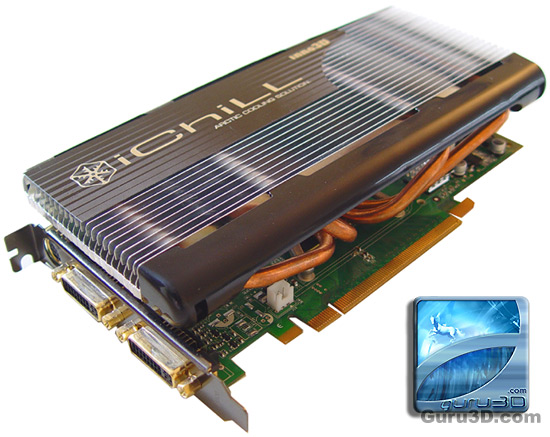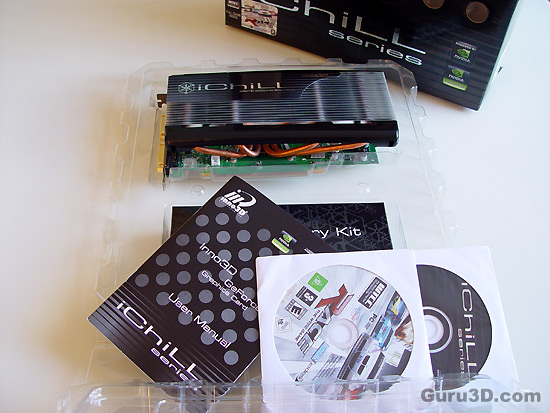Page 2
A cats eye on G71
At this stage we'll do a little Copy and Paste from our original 7950 GT review; we'll briefly look at the technology behind the GeForce 7950 microarchitecture, the cards versus bundles, some features, power consumption, heat management and the very obvious... noise :)
So then the GeForce 7950 GT is pretty much the same graphics processor as the GeForce 7900 GT yet clocked slightly faster. This is what the industry calls a refresh product. More of the same, yet a different configuration to adapt and address the market in a better way or to adapt towards competitor products.
I do agree with a lot of you guys, it's getting to be a jungle in the computer stores, consumers do not have a clue what the differences are anymore as there are too many products saturating and cluttering the market for the end-user to comprehend what exactly they are buying.
Hey luckily for you you're on Guru3D.com, we just love to explain it to you. Let's have a look at the some product specifications and compare them to understand where the differences are to be found.
|
NVIDIA GeForce 6 & 7 Product Lineup Specifications | ||||||
|
Product Name |
# pixel processors |
# vertex processors |
Bus width |
Memory Type/Amount |
GPU Speed |
RAM Speed |
| GeForce 7950 GX2 | 24(x2) | 8x2 | 256-bit | GDDR3/512MB (x2) | 500MHz | 1200 MHz |
| GeForce 7900 GTX | 24 | 8 | 256-bit | GDDR3/512MB | 650MHz | 1600 MHz |
| GeForce 7950 GT | 24 | 8 | 256-bit | GDDR3/512MB | 550MHz | 1400 MHz |
| GeForce 7900 GT | 24 | 8 | 256-bit | GDDR3/256MB | 450MHz | 1320 MHz |
| GeForce 7900 GS | 20 | 7 | 256-bit | GDDR3/256MB | 450MHz | 1320 MHz |
| GeForce 7800 GTX | 24 | 8 | 256-bit | GDDR3/512MB | 560MHz | 1600 MHz |
| GeForce 7800 GTX | 24 | 8 | 256-bit | GDDR3/256MB | 430MHz | 1200MHz |
| GeForce 7800 GT | 20 | 7 | 256-bit | GDDR3/256MB | 400MHz | 1000MHz |
| GeForce 7800 GS | 16 | 6 | 256-bit | GDDR3/256MB | 375MHz | 1200MHz |
| GeForce 7600 GT | 12 | 5 | 128-bit | GDDR3/256MB | 560MHz | 1400MHz |
| GeForce 7600 GS | 12 | 5 | 128-bit | GDDR2/256MB | 500MHz | 1400MHz |
| GeForce 7600 GS | 12 | 5 | 128-bit | GDDR2/256MB | 400MHz | 800MHz |
|
GeForce 6800 Ultra |
16 |
6 |
256-bit |
GDDR3/256MB |
400MHz |
1100MHz |
|
GeForce 6800 GT |
16 |
6 |
256-bit |
GDDR3/256MB |
350MHz |
1000MHz |
| GeForce 6800 GS PCX | 12 | 5 | 256-bit | GDDR3/128/256MB | 425MHz | 1000MHz |
| GeForce 6800 GS AGP | 12 | 5 | 256-bit | GDDR3/128/256MB | 350MHz | 1000MHz |
|
GeForce 6800 |
12 |
5 |
256-bit |
GDDR/128MB |
325MHz |
700MHz |
|
GeForce 6800 LE |
8 |
4 |
256-bit |
GDDR/128MB |
320MHz |
700MHz |
| GeForce 6600 GT | 8 | 3 | 128-bit | GDDR3/128/256MB | 500MHz | 1000MHz |
| GeForce 6600 | 8 | 3 | 128-bit | GDDR/128MB | 300MHz | 275(550) |
| GeForce 6200 | 4 | 3 | 64/128-bit | GDDR/128MB/256MB | 300MHz | 275(550) |
So what you need to be comparing to the most is the GeForce 7900 GT 256MB. The big differences are, a 100 MHZ faster core clock, an 80MHz faster memory clock and optional an extra 256MB of framebuffer/memory. Other then that there are virtually no differences between both cards in terms of features or anything. It has 24 pixel shader processors, eight vertex units, 16 ROPS; in short, this is the 0.09 micron G71 graphics core which makes us call this a refresh product. The entertaining part is, for roughly 300 bucks you can get a top-segment mid-range product slash lower segment high-end graphics card in your system and that's fascinating for sure, yet it is competing with GeForce 8800 GTS.
Compared to the 7900 GTX the card is producing much less heat due to the lower clocks and a nice side-effect of that is that it's a single slot solution whereas the GTX has the bigger dual slot heat pipe cooler.
Okay, some other specifications.
- 8 Vertex Shading Units
- 24 Pixel pipelines
- 256/512MB 256-bit 1.4ns (8x32) GDDR3 Memory
- PCI Express x16 Compatibility (PCI Express Compliant)
- Integrated NVIDIA TV Encoder (HDTV, S-Video, Composite,)
- Integrated NVIDIA VIVO (S-Video, Composite,)
- Dual DVI-I Connectors
- NVIDIA PureVideo Technology
- DVD + HDTV Decode assist up to 1920x1080p resolution
- Integrated Dual 400MHz RAMDACs
- Two Dual Link TMDS DVI Connector
- NVIDIA Digital Vibrance Control (DVC) 3.0
- Support for Microsoft Video Mixer Renderer (VMR)
- Advanced adaptive de-interlacing
Inno3D GeForce 7950 GT 256MB iChill (passive cooler)
Right then, the Inno3D GeForce 7950 GT when you look at it is a 100% reference design based card. It comes with a default green PCB (I would have really loved another color) but most definitely the AC (Arctic cooling) cooler makes up for a lot.
Once you open up the beautifully designed box you'll notice that huge radiator on top of the graphics cards. Cool but weird looking in a strange way. You'll receive a plethora of cables, CDs and connectors and you'll receive a full free game: RACE the WTCC game, which is a nice title.
Since this product is an iChill product, you'll receive a lovely 3 year warranty which is a lot considering how fast this card is pre-clocked for you (we'll explain that in a second) and combined with the fact it's passively cooled (much hotter product).
The next thing you'll notice on that graphics card is detail, over the entire board you'll find top quality solid capacitors for stable power voltage and hopefully durability. And then the gold-plated connectors will catch your eye; the gold plated DVI connectors ensure better signal quality and less oxidization. Well, this can be debated, but it certainly looks nice.

As I've explained, this is a passively cooled product. This immediately means that heat is an issue. It didn't stop Inno3D from pre-clocking this product a little higher than the normal models for you though. And that's great as most models are 512MB, this one is 256MB. The faster clocks will give it a little more edge over the competition.
So as you know all GeForce series 7 products have two primary clock frequencies (there are more but two are relevant for you).
The graphics core on a normal 7950 GT is running at 550 MHz and the memory at 1400 MHz. This iChill version comes with a default pre-overclock at 560 MHz on the graphics core and 1500 MHz on the memory. This by itself offers a little more performance. Usually we do see higher "pre-clocks"; yet bare in mind we are dealing with passive cooling here.
It's really nice to see this. But can we maintain steady temperatures with such a product and overclock ? Well yes it can.
The cooler, it does look a tad weird doesn't it? But hey it works quite well. Now, the cooler is manufactured by Arctic cooling. We reviewed some of their coolers ourselves, and as you might recall the company HiS has been using these coolers in there IceQ range as well. Two things you really need to know about these coolers is that they work silently and offer great cooling. This passive design is actually the Accelero S1M which comes with 24 alu fins and is based on a four-way heatpipe design. The good thing about these coolers is that they can draw enough heat away from the GPU to keep it stable without any noise. The bad thing however is that it's a lot of heat, and that's dumped inside your PC. So you will need some sort of ventilation in your PC chassis if you play games a lot.
Also notice the smaller details; even the memory has little ramsinks (which quite honestly have no use with BGA memory these days), but they do look cool and again bring detail and aesthetics to the product. In short, nice !
Alright let's have a look inside the box shall we. Once we open it up we'll see:
- GeForce 7950 GT with AC Accelero S1M passive cooler
- Driver CD
- Full game - RACE the WTCC game
- 6-pin to molex power connector
- HDTV 3-way RCA (analog) component connector.
- Composite VIDEO cable
- DVI-VGA dongle

There's nothing much to be said here other then you'll receive all the basics to get started including a full game.
